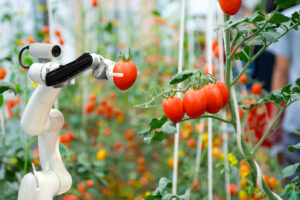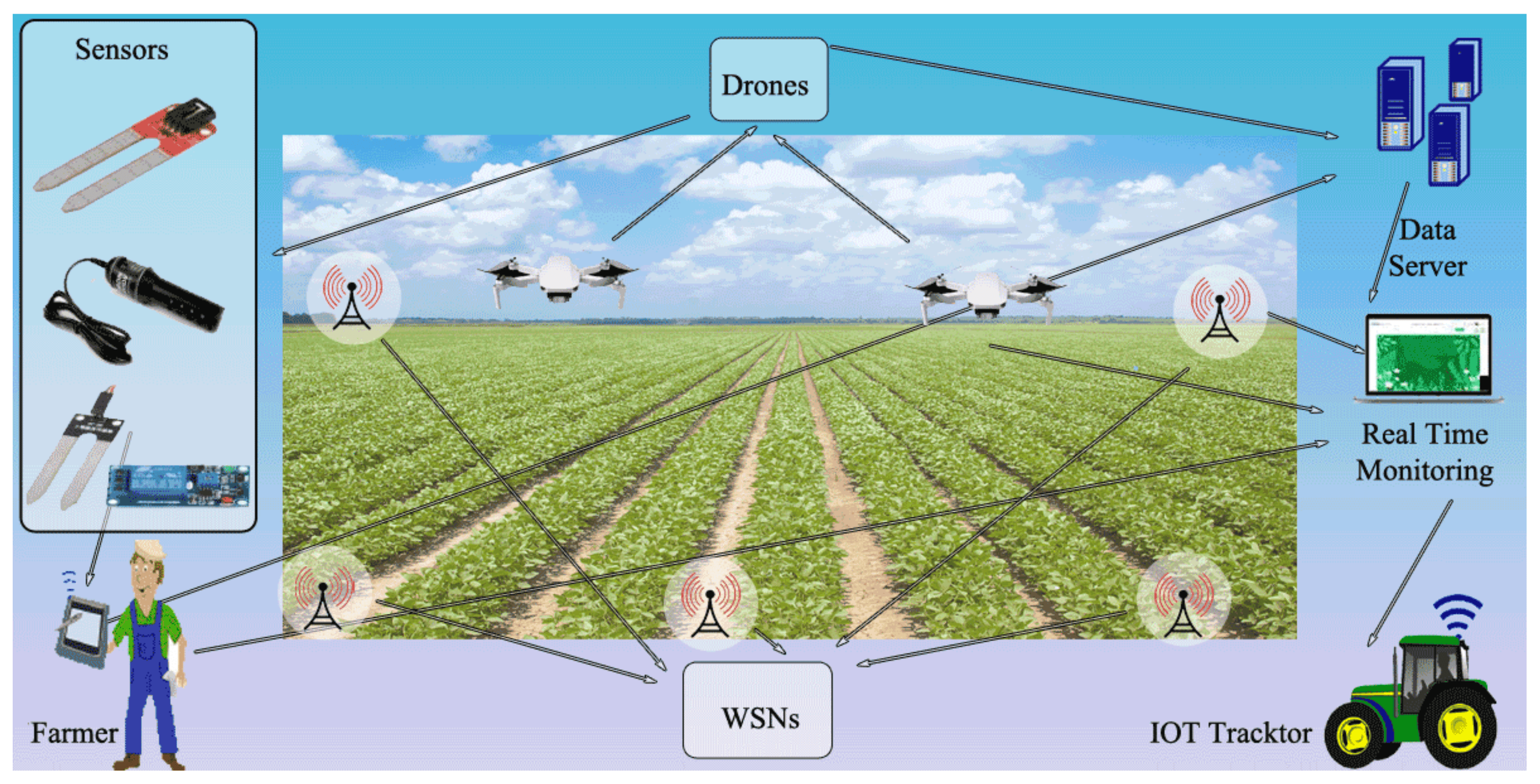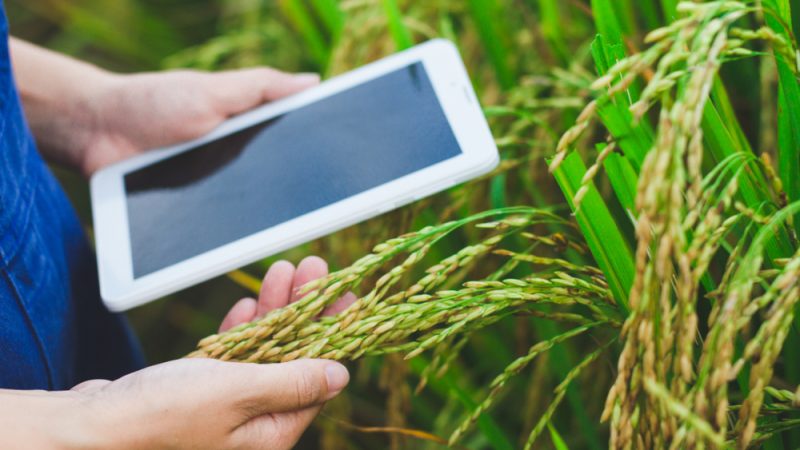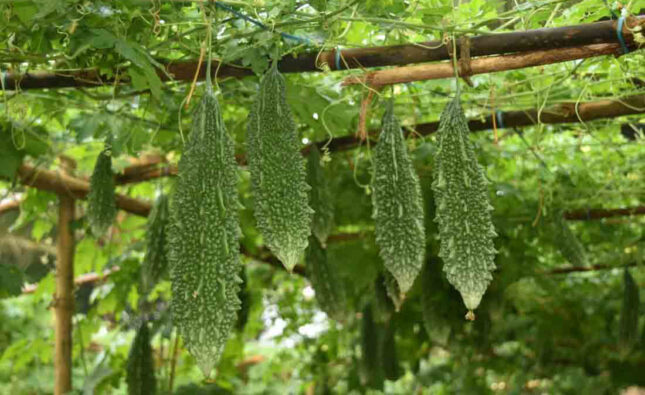Smart Farming-The Future of Agriculture: A Complete Guide
Smart agriculture farming, also known as precision agriculture or smart farming, refers to the use of advanced technologies and data-driven techniques to optimize agricultural practices and improve overall efficiency, productivity, and sustainability in farming operations. It involves the integration of various technologies such as Internet of Things (IoT), sensors, drones, artificial intelligence (AI), big data analytics, and automation to monitor, manage, and control agricultural processes.
The key objective of smart agriculture farming is to make more informed decisions by collecting and analyzing real-time data from the farm. This data can be obtained through sensors embedded in the soil, plants, or even livestock, which measure parameters like temperature, humidity, soil moisture, nutrient levels, and animal behavior. Drones or satellite imagery can also be used to gather data on crop health, pest infestations, or irrigation needs.
Once the data is collected, advanced analytics and AI algorithms are used to interpret and analyze the information. This enables farmers to gain valuable insights into crop conditions, optimize resource allocation, detect diseases or pests at an early stage, and adjust irrigation and fertilizer application rates accordingly.
By precisely targeting inputs and interventions, farmers can reduce waste, minimize environmental impact, and improve overall crop yield and quality. Smart agriculture farming also involves automation and control systems that can be remotely operated or programmed to perform specific tasks.
For example, automated irrigation systems can be controlled based on real-time weather data and soil moisture levels to deliver water precisely where and when it is needed, conserving water resources. Similarly, autonomous robots or drones can be deployed for tasks such as seeding, spraying pesticides, or harvesting, reducing the need for manual labor and increasing efficiency.
Overall, smart agriculture farming aims to optimize resource utilization, increase productivity, reduce costs, and enhance sustainability in agriculture. It empowers farmers with valuable insights and tools to make informed decisions, ultimately leading to more efficient and environmentally friendly farming practices.
Here are some key components and practices commonly associated with smart farming:
1. IoT and Sensors:
Smart farming relies on the deployment of sensors and IoT devices throughout the farm to gather data on various parameters such as soil moisture, temperature, humidity, nutrient levels, and crop health. These sensors provide real-time information and enable farmers to monitor and manage their crops and livestock more effectively.
-
Monitoring Environmental Conditions:
IoT sensors can collect data on various environmental factors such as temperature, humidity, soil moisture, light intensity, and weather conditions. This information helps farmers understand the current state of their farm and make appropriate adjustments. For example, sensors can alert farmers when soil moisture levels are low, signaling the need for irrigation.
-
Crop Health Monitoring:
Sensors placed in the field can monitor the health of crops by measuring parameters like chlorophyll levels, leaf temperature, or photosynthesis rates. This data enables early detection of diseases, nutrient deficiencies, or pest infestations. By identifying issues promptly, farmers can take targeted actions, such as applying pesticides or adjusting fertilizer levels, to mitigate crop losses.
-
Livestock Monitoring:
Sensors attached to livestock can track animal behavior, health indicators, and location. For example, sensors can monitor body temperature, heart rate, or feeding patterns to detect signs of illness. Additionally, GPS-enabled sensors can help farmers locate and manage their animals, ensuring their well-being and reducing the risk of loss.
-
Soil Monitoring:
Soil sensors measure critical parameters like moisture content, pH levels, and nutrient composition. This information helps farmers optimize irrigation and fertilization practices, ensuring that crops receive the right amount of water and nutrients. By avoiding overuse or underuse of resources, farmers can reduce costs and minimize environmental impact.
-
Weather Monitoring:
IoT weather stations collect data on rainfall, wind speed, solar radiation, and temperature variations. This information is valuable for predicting weather patterns, identifying potential risks (e.g., frost or heatwaves), and planning farm operations accordingly. It enables farmers to optimize irrigation schedules, adjust planting dates, or take preventive measures to protect crops from adverse weather conditions.
-
Equipment Monitoring and Automation:
IoT sensors can be installed on farm machinery and equipment to monitor their performance, fuel levels, or maintenance needs. This enables predictive maintenance, reducing downtime and improving operational efficiency. Furthermore, sensors integrated with automated systems can control and optimize processes such as irrigation, fertilization, or pest control, based on real-time data.
-
Data Collection and Analysis:
IoT devices and sensors generate vast amounts of data. This data can be collected, transmitted, and analyzed to derive actionable insights. Advanced analytics and AI algorithms can process this information to provide farmers with valuable recommendations, such as optimal planting strategies, resource allocation, or yield predictions.

Picture of IoT and Sensors
2. Precision Farming Techniques:
Precision farming techniques, also known as site-specific farming or variable rate technology, involve the use of advanced technologies to tailor agricultural practices and inputs to specific areas within a farm, taking into account variations in soil conditions, crop needs, and other factors. These techniques enable farmers to optimize resource utilization, increase efficiency, and improve overall productivity. Here are some common precision farming techniques:
-
Soil Mapping and Sampling:
Precision farming starts with detailed soil mapping and sampling. Soil sensors, GPS technology, and remote sensing tools are used to create high-resolution soil maps that identify variations in soil properties such as texture, pH, organic matter content, and nutrient levels. This information helps farmers understand the soil variability within their fields and make appropriate management decisions.
-
Variable Rate Application (VRA):
With VRA, inputs such as fertilizers, pesticides, and irrigation water are applied at variable rates based on the specific needs of different areas within a field. Using GPS and mapping technologies, farmers can precisely target these inputs to areas where they are required most. For example, fertilizer application can be adjusted based on soil nutrient levels, reducing waste and optimizing nutrient uptake by crops.
-
Precision Seeding:
Precision seeding involves adjusting the seed planting density and spacing based on soil conditions and crop requirements. By using variable-rate seeders equipped with GPS and mapping technology, farmers can optimize seed placement to achieve uniform plant stands and maximize yield potential.
-
Remote Sensing and Imagery:
Remote sensing techniques, including satellite imagery, aerial drones, and ground-based sensors, provide valuable data on crop health, vigor, and growth patterns. By analyzing this data, farmers can identify areas of stress, disease outbreaks, or nutrient deficiencies in real-time. This enables targeted interventions and adjustments to optimize crop management.
-
Remote Monitoring and Telemetry:
Remote monitoring systems, integrated with sensors and IoT devices, enable farmers to track environmental conditions, soil moisture, plant health, and other variables in real-time. This information helps farmers make timely decisions and take appropriate actions to address issues or optimize resource use.
-
Automated Irrigation:
Precision farming utilizes automated irrigation systems that adjust water application based on real-time data. Soil moisture sensors and weather forecasts inform the irrigation scheduling, ensuring that crops receive the optimal amount of water when and where it is needed. This approach minimizes water waste, reduces energy consumption, and prevents water stress or overwatering.
-
Data Analytics and Decision Support Systems:
Precision farming relies on data analytics and decision support systems to process and analyze large volumes of data collected from various sources. By applying advanced algorithms and AI models, these systems provide actionable insights and recommendations for optimal farm management practices. By implementing precision farming techniques, farmers can achieve more efficient resource allocation, reduced input costs, minimized environmental impact, improved crop health and yields, and enhanced overall sustainability. It allows for site-specific management decisions that cater to the unique needs of each area within a farm, resulting in optimized agricultural production.

Picture is showing Precision Farming Techniques
3. Automated Systems:
Automated systems play a significant role in smart agricultural farming by leveraging technology to perform tasks efficiently, accurately, and autonomously. These systems use robotics, sensors, artificial intelligence, and other technologies to automate various processes in farming operations. Here are some examples of automated systems in smart agricultural farming:
-
Automated Irrigation Systems:
These systems use sensors, weather data, and pre-set parameters to control the timing, duration, and amount of water delivered to crops. They ensure precise irrigation based on real-time needs, optimizing water usage and reducing waste.
-
Robotic Planting and Seeding:
Robots equipped with vision systems and robotic arms can accurately plant seeds or transplant seedlings at the desired spacing and depth. This automation improves planting efficiency, reduces labor requirements, and ensures uniform plant distribution.
-
Robotic Weed Control:
Autonomous robots or drones equipped with cameras and AI algorithms can identify and selectively target weeds in fields. They can apply herbicides directly to the weeds, minimizing chemical use and reducing manual labor for weed management.
-
Robotic Harvesting:
Automated harvesting systems use robotic arms or machines to pick fruits, vegetables, or other crops at the right time. These systems are designed to handle delicate produce, increase harvesting speed, and reduce labor costs.

Image is showing Robotic Harvesting
-
Drone Technology:
Drones equipped with high-resolution cameras and sensors can collect aerial imagery and data on crop health, growth patterns, and pest infestations. This information helps farmers monitor field conditions, detect issues, and make informed management decisions.
-
Livestock Monitoring and Management:
IoT sensors attached to animals can monitor their location, health parameters, and behavior. Automated systems can analyze this data to detect anomalies, track grazing patterns, and provide alerts for potential health issues or birthing events.
-
Robotic Milking Systems:
Robotic milking machines are used in dairy farming to automate the milking process. These systems clean udders, attach milking cups, monitor milk quality, and record data, reducing the manual labor required for milking operations.
-
Climate Control Systems:
Automated systems can regulate environmental conditions in controlled environments such as greenhouses or livestock barns. They monitor and adjust parameters such as temperature, humidity, ventilation, and lighting to create optimal conditions for plant growth or animal comfort.
-
Data-driven Decision Support Systems:
Automated systems integrate data from various sources, including sensors, weather stations, and crop models, to provide farmers with real-time insights and recommendations. These systems help optimize resource allocation, crop management, and other operational decisions.
The use of automated systems in smart agricultural farming improves efficiency, accuracy, and productivity. By reducing manual labor requirements, minimizing resource waste, and optimizing farm operations, these systems contribute to sustainable and profitable farming practices.

Image is showing Automated Systems in the smart farming
4. Farm Management Software:
Farm management software is an integral part of smart farming, providing farmers with digital tools to streamline and optimize their farm operations. This software incorporates various functionalities and features that help farmers manage and monitor different aspects of their farms efficiently. Here are some key features and benefits of farm management software in smart farming:
-
Planning and Record Keeping:
Farm management software enables farmers to plan their operations, such as crop rotations, planting schedules, and input management. It allows them to keep detailed records of activities, including seeding, fertilization, irrigation, pest control, and harvesting. These records provide valuable historical data for analysis and decision-making.
-
Inventory Management:
The software helps farmers track and manage their inventory of seeds, fertilizers, chemicals, equipment, and other inputs. It provides real-time visibility into stock levels, expiration dates, and usage, ensuring timely replenishment and reducing waste or stockouts.
-
Resource Allocation and Optimization:
Farm management software helps optimize the allocation of resources such as labor, machinery, and irrigation. By integrating data from sensors, weather forecasts, and crop models, the software assists farmers in making informed decisions on resource allocation to maximize efficiency and productivity.
-
Crop Monitoring and Analytics:
The software integrates data from various sources, including IoT sensors, drones, satellites, and weather stations, to monitor crop health, growth, and environmental conditions. It provides visualizations, analytics, and alerts to help farmers detect issues early, make data-driven decisions, and take targeted actions to optimize crop management.
-
Financial Management:
Farm management software includes features for financial management, budgeting, and cost analysis. It helps farmers track expenses, income, and profitability for different crops or enterprises. It can generate financial reports, calculate costs per unit, and evaluate the financial performance of the farm.
-
Mobile Connectivity and Remote Monitoring:
Many farm management software platforms offer mobile applications or cloud-based access, enabling farmers to monitor and manage their operations remotely. They can access real-time data, receive notifications, and make decisions on the go, improving efficiency and flexibility in farm management.
-
Data Integration and Compatibility:
Farm management software facilitates the integration of data from different sources and technologies, such as IoT sensors, GPS, weather data, and machinery. It allows seamless data exchange, reducing manual data entry and ensuring compatibility across various systems and devices.
-
Compliance and Traceability:
The software helps farmers adhere to regulatory requirements and certifications. It enables tracking and documentation of inputs used, treatments applied, and other relevant information for traceability and compliance purposes.
-
Collaboration and Communication:
Farm management software often includes collaboration features, enabling farmers to communicate and share information with agronomists, consultants, and farm staff. It facilitates collaboration on planning, tasks, and decision-making, promoting effective teamwork. Farm management software enhances operational efficiency, data-driven decision-making, and overall farm productivity in smart farming. By centralizing information, automating tasks, and providing valuable insights, this software empowers farmers to optimize their operations, reduce costs, and improve sustainability.

Image of Farm Management Software in the Smart Farming
5. Remote Monitoring:
Smart farming enables farmers to remotely monitor their fields and livestock using connected devices, cameras, and drones. This facilitates real-time observation and response to changes in environmental conditions or livestock behavior.

Image of Remote Monitoring in the smart farming
6. Crop Health and Disease Management:
By utilizing data from sensors and image analysis, farmers can detect early signs of plant diseases, nutrient deficiencies, or pest infestations. This enables targeted interventions and minimizes crop losses. The goal of smart farming is to optimize resource utilization, improve productivity, reduce environmental impact, and enhance overall farm efficiency. By leveraging technology and data, farmers can make more informed decisions, increase yields, and contribute to sustainable agriculture practices.
-
Remote Sensing and Imaging:
Remote sensing technologies, including satellite imagery, drones, and sensors, are used to monitor crop health and detect early signs of diseases or pest infestations. These technologies provide high-resolution images or data that can be analyzed to identify areas of stress, nutrient deficiencies, or anomalies in crop growth patterns.
-
Disease and Pest Detection:
Smart farming utilizes various sensors, including hyperspectral or multispectral sensors, to detect specific spectral signatures associated with diseases, pests, or nutrient deficiencies. This allows for the early detection of potential issues, enabling farmers to take timely action and mitigate the spread of diseases or pests.
-
Data Analytics and AI:
Advanced analytics and AI algorithms are employed to analyze data collected from sensors, imagery, and historical records. These algorithms can identify patterns, correlations, and anomalies to provide insights on disease progression, pest behavior, and optimal treatment strategies. AI-powered disease prediction models can help forecast disease outbreaks based on environmental and crop conditions.
-
Integrated Pest Management (IPM):
Smart farming emphasizes the use of Integrated Pest Management strategies, which involve a combination of preventive measures, biological control agents, and targeted pesticide applications. IPM incorporates data-driven approaches to optimize the timing and dosage of pesticide application, minimizing environmental impact while effectively managing pests.
-
Decision Support Systems:
Decision support systems (DSS) in smart farming provide real-time information and recommendations for disease and pest management. These systems integrate data from multiple sources, such as sensors, weather forecasts, and disease models, to assist farmers in making informed decisions on disease prevention, treatment timing, and selection of suitable control methods.
-
Precision Application Techniques:
Smart farming utilizes precision application techniques, such as variable-rate technology and site-specific spraying, to optimize the application of pesticides or fungicides. By considering factors such as disease pressure, crop growth stage, and environmental conditions, farmers can precisely target affected areas and minimize chemical use.
-
Crop Rotation and Diversity:
Crop rotation and diversification practices are employed to break disease cycles and reduce the buildup of pathogens in the soil. Smart farming systems help farmers plan and optimize crop rotations based on disease susceptibility, nutrient requirements, and overall farm management goals.
-
Early Warning Systems:
Smart farming incorporates early warning systems that utilize real-time data and predictive models to alert farmers about disease or pest risks. These systems take into account factors such as weather conditions, crop growth stage, and historical disease occurrence to provide timely warnings and recommend appropriate preventive or control measures. By leveraging advanced technologies and data-driven approaches, smart farming enables farmers to proactively monitor crop health, detect diseases or pests early, optimize treatment strategies, and reduce the overall impact of diseases and pests on crop yields. This leads to more sustainable and efficient crop management practices.

Image of Crop Health and Disease Management through Smart






